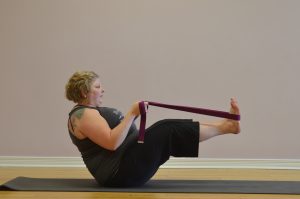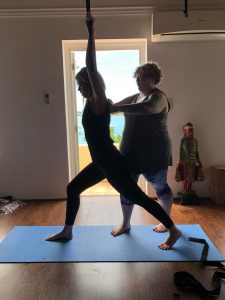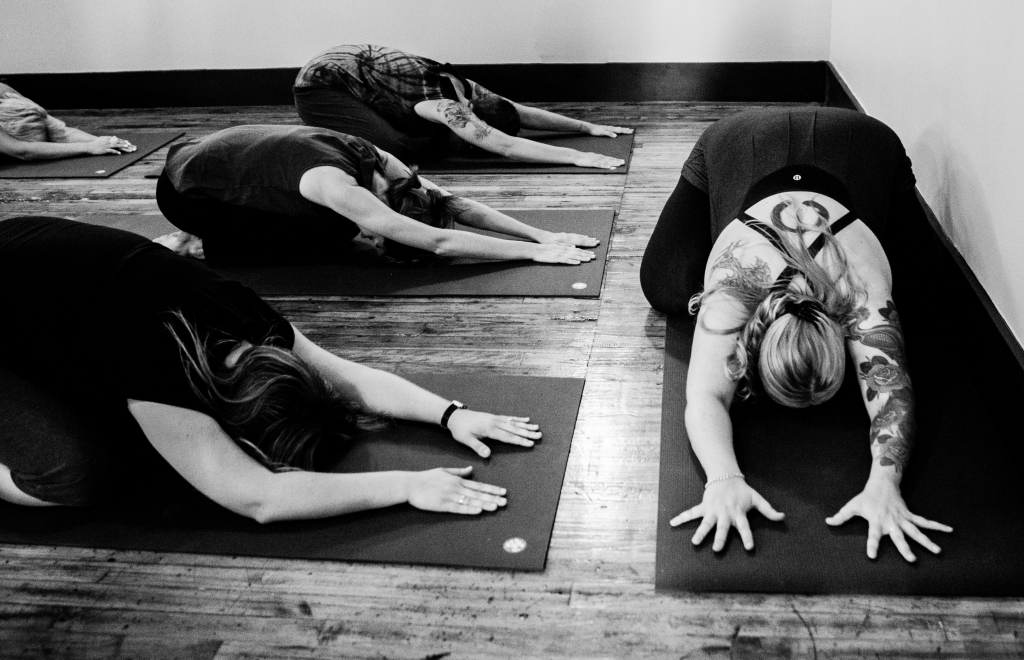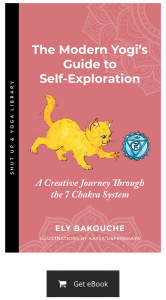Our voice is a huge element of our identity. It’s indistinguishable from how other people see us. Our connection with others can thrive or suffer based on our register, timbre, prosody, pace, pitch, and volume as well as, maybe most importantly, our choice of language. As yoga teachers, when we discuss language and its impact on our students, we could talk about supporting different types of learning styles, crafting meaningful class descriptions, creating content to bridge an online and offline audience, and a myriad of other thought-provoking conversations. For this piece, I really want to focus on how we can use our language to make our classes more inclusive.
The body is not the problem to be solved.
I often use elements of body positivity as a framework for discussions of inclusivity. I define body positivity as the birthright of each individual to exist and participate in the world as equal to every other human being. It involves the removal of judgement associated with physical appearance or ability and recognition of people as human.
In Western culture, the body is often analyzed, commercialized, stigmatized, and otherwise marginalized. As a microcosm of our lives off of the mat, the yoga studio can become a reflection of that phenomenon as well. Asana is often cued, by default, for an able-bodied, thin, flexible, strong ideal. Now, accessibility has begun to infiltrate the ethos, so I might hear teachers cue “if you’re not flexible enough” or “if you can’t do that” and invite students to use props in a very defined way, so their inept bodies no longer stop them from experiencing the pose.
In this scenario, we are perpetuating the belief that the body is the problem to be solved. I challenge you to shift focus so that the body is not the problem, but the elements that make up a pose are the problems.
Break apart these big skills to their parts and give everyone in the room the opportunity to participate in a progressive strength building experience by offering a range of options that all focus on the same elements.

As an example, if we’re working on Plank, we can begin in Table and learn how the arms, shoulders, and core work together to support us against gravity. I like to offer questions that encourage people to decide for themselves how to best move their bodies, as opposed to cueing in a specific, almost prescriptive, way. Usually, for reasons informed by principles of exercise science, I encourage students to work at about 60-70% of effort, or on a scale of 6-7 out of 10 when it comes to sensation. If Table is already beyond that, unload the movement by taking your hands off the floor and onto blocks or the wall. If this option is still not possible, if it’s causing pain, for example, you could skip the movement altogether and visualize yourself doing the movement. If Table is less than 6-7 out of 10, start to inch your knees away from your hands and continue to do so, slowly and with attention, until you find yourself in any shape somewhere between Table and Plank. If you get to Plank and find that’s still not 6-7 out of 10, then we can begin to elevate the feet, first onto blocks, then up the wall.
I like to offer questions that encourage people to decide for themselves how to best move their bodies, as opposed to cueing in a specific, almost prescriptive, way.
There are always ways to decrease and increase the load to ensure that everyone is practicing in a safe and efficient way. The value of each person’s expression is emphasized as I praise good effort and progression over the achievement of any particular skill. The goal, now, is not necessarily Plank, but strength building along this spectrum, staying present, having an embodied experience, and exerting 60-70% of effort.
Offer and Celebrate All Options Enthusiastically
Breaking down a pose to its parts will go a long way in doing so but offering “options” instead of “variations” will also help to subtly reinforce the idea that everyone can express asana differently. Using language like “if you can’t take the bind, it’s okay to leave your hand at your waist” or “if your arms aren’t long enough to bind, you can use a strap” establishes that taking a bind is the ultimate goal and any other expression is subpar. This creates a hierarchy of asana where there is still an ultimate goal of a peak pose.
As you demonstrate all expressions of a pose (and sometimes, intentionally, the most accessible one), you can present choices – “maybe like this, maybe like this, maybe like this” – or, better yet, you can reinforce the idea that your students know their bodies best and encourage them to create a shape according to a particular goal instead of a defined alignment (e.g., “stand in a way where you feel the most strong and stable” instead of “standing with your big toes together, heels apart”).
Try to Invite, Instead of Command
The vast majority of yoga classes are taught with command language, meaning you are told to “lift your leg,” “lower to the floor,” or “step back.” Some schools of yoga teach their trainees to cue in this way because it’s efficient during a Vinyasa sequence, and it ensures that students hear the important directions. This may be so, but it also creates a power dynamic where the teacher is the authority. It leaves no space for any other options, so those who find themselves unable to practice in this way are left feeling excluded.

As my intention is to empower students to be present, embodied, and practice in a way that best supports their needs, I prefer using invitational cueing by moving as a community and adding “-ing” to what would have otherwise been a command. For example, “lifting your leg,” “let’s lower to the floor together,” or “stepping back.” The intention is to invite students into a pose rather than dictate that they do something. This is a small shift that makes a huge difference.
I prefer using invitational cueing by moving as a community and adding “-ing” to what would have otherwise been a command.
Don’t “Should” All Over Your Students
In an effort to communicate their intention for teaching a pose, many teachers will try to facilitate an experience by saying things like “you should be feeling a deep stretch in your side body,” “notice how much space you’ve created in your low back,” or “let go of tension through the breath.” While this may be the teacher’s felt sense in a particular pose, it’s important to know that not everybody experiences sensation the same way. Maybe others in the class are feeling what you’re feeling, but those who aren’t might shut down what they’re feeling and convince themselves that they, too, are experiencing what you described. Worse still, a student may feel like something is wrong with them if their experience is different than what you’re saying they “should” be feeling.
Say Less, Inquire More
Rather than telling students what their practice “should” feel like and commanding them to move in a defined way with the pose as the goal and the body as the problem, I encourage teachers to stay curious, ask questions, and invite their students to do the same. Our job is to introduce a stimulus and then let each person’s self-organizing system integrate that information, while we hold space and stay present.

I encourage students to stay grounded, open-minded, embodied, and curious about sensations. If something feels great, pursue more of that. If it doesn’t, we don’t need to analyze why that may be, but make changes to the shape until it does feel good or decide to step away from it for now. You may have people in your class who have been doing yoga for many years practicing alongside people who are there for the very first time. Emphasize to your students that their practices are their own. Encourage them to realize that they are each their most important teacher. This gives students agency to take their practice into their own hands, rather than relying on a teacher to tell them what to do.
Let the Silence Do the Heavy Lifting
Finally, to truly hold space for students to feel empowered in their experience, it’s important to remember to include a healthy dose of silence, especially when you’re not sure what to say. As I like to say in my teacher training programs “let the silence do the heavy lifting.” Be critical about what you chose to say and sensitive to when you may be filling the space unnecessarily.

For example, if you’re not teaching a specific skill, is it necessary to say “from your back, coming to sit. So, bring your left arm over your head and roll to your left side, using your left arm as a pillow. Now, kick out with your right leg as you push into the floor with your hands. Swinging the legs around to come to a cross-legged shape with your right leg in front of your left leg”? Maybe it’s enough to simply say “Coming to sit” and then hold space for students to find their own way there. Filter. Edit. Say less. And, when you do speak, say it slower with lots of time between each thought.
Try it for yourself! In making space for all people and their expressions of the practice, try invitational cues such as these the next time you’re teaching a yoga class:
- Notice what you’re feeling.
- Before we do the other leg, compare the level of tension and ease you’re experiencing in your left leg to your right leg.
- When I practice this pose, I really feel my hamstrings working.
- This pose has been known for creating space in the low back.
- Maybe your arms are like this, maybe like this, maybe something completely different.
- What would it look like for you to feel supported in this pose?
Through the careful consideration of all elements of our teaching, including our language, we can help shape the future of yoga to be safe, inclusive, compassionate, and empowering. As creators of space, yoga teachers have the opportunity to uncover for their students an inherent sense of value. When their efforts are celebrated as perfectly complete offerings to themselves and one another – each expression as important as another – students gradually redefine the value of their practice. As they do so, their focus becomes clearer, and they see more of their gifts, exactly as they are today, and less of their vulnerabilities or perceived weaknesses.

By cueing as an invitation, we give agency to all our students to take back the power of their own practice. When we invite and welcome all expressions, rather than prescribe movements, we present ourselves as a guide. Invitational cueing with words like “explore,” “try,” or “inquire” also serve to destigmatize the practice, remove any hierarchy of poses, and empower your students with an embodied experience of feeling capable and valuable.
Photos from the author
Edited by Ely Bakouche




